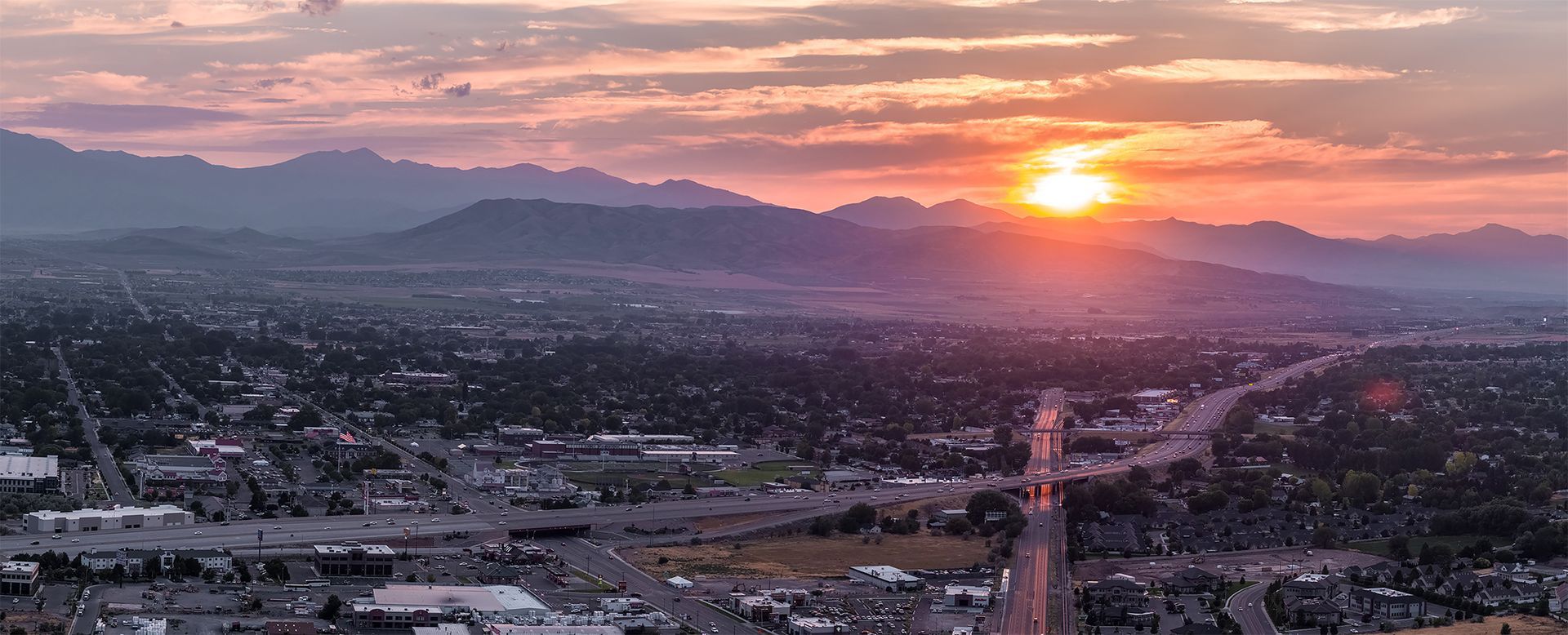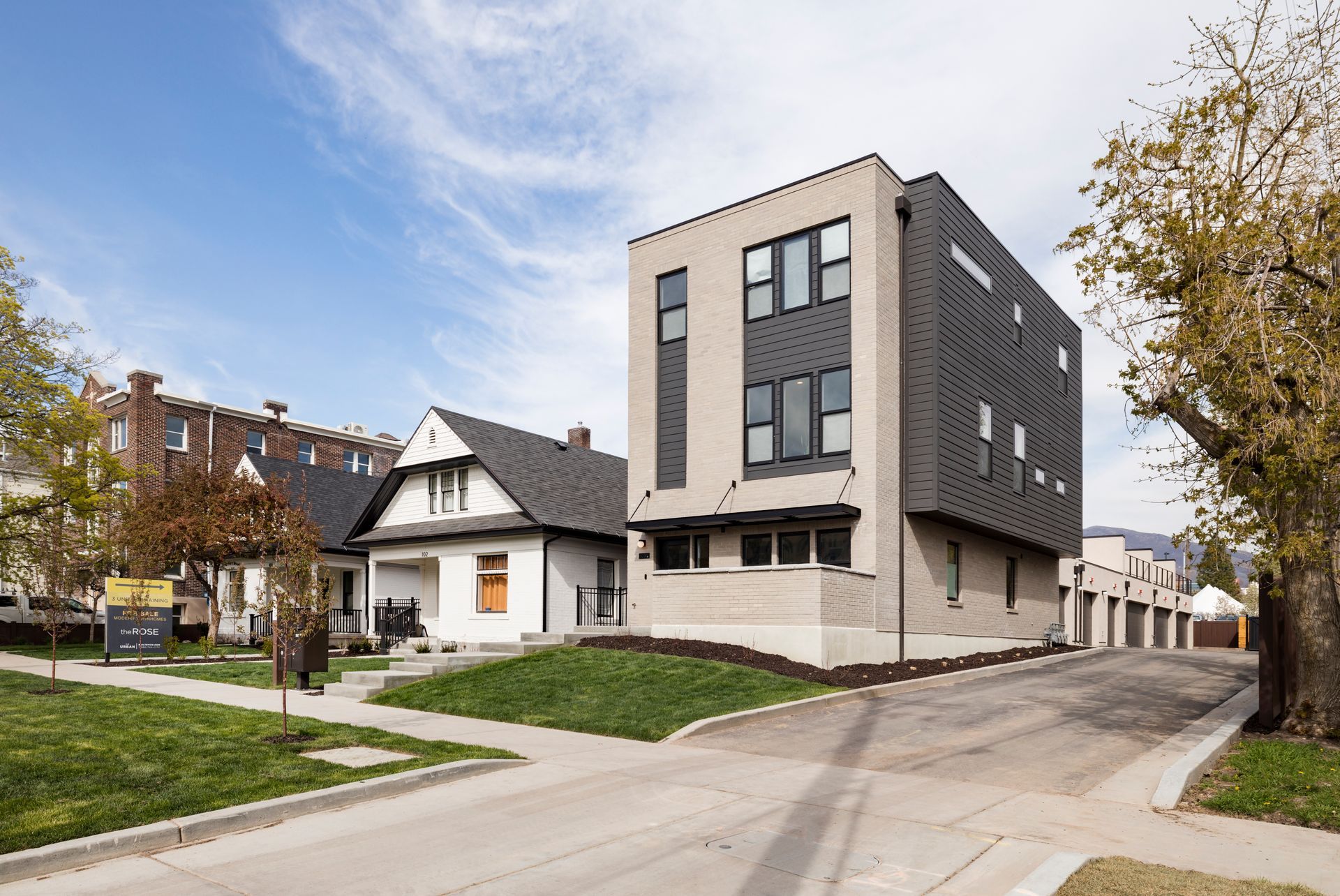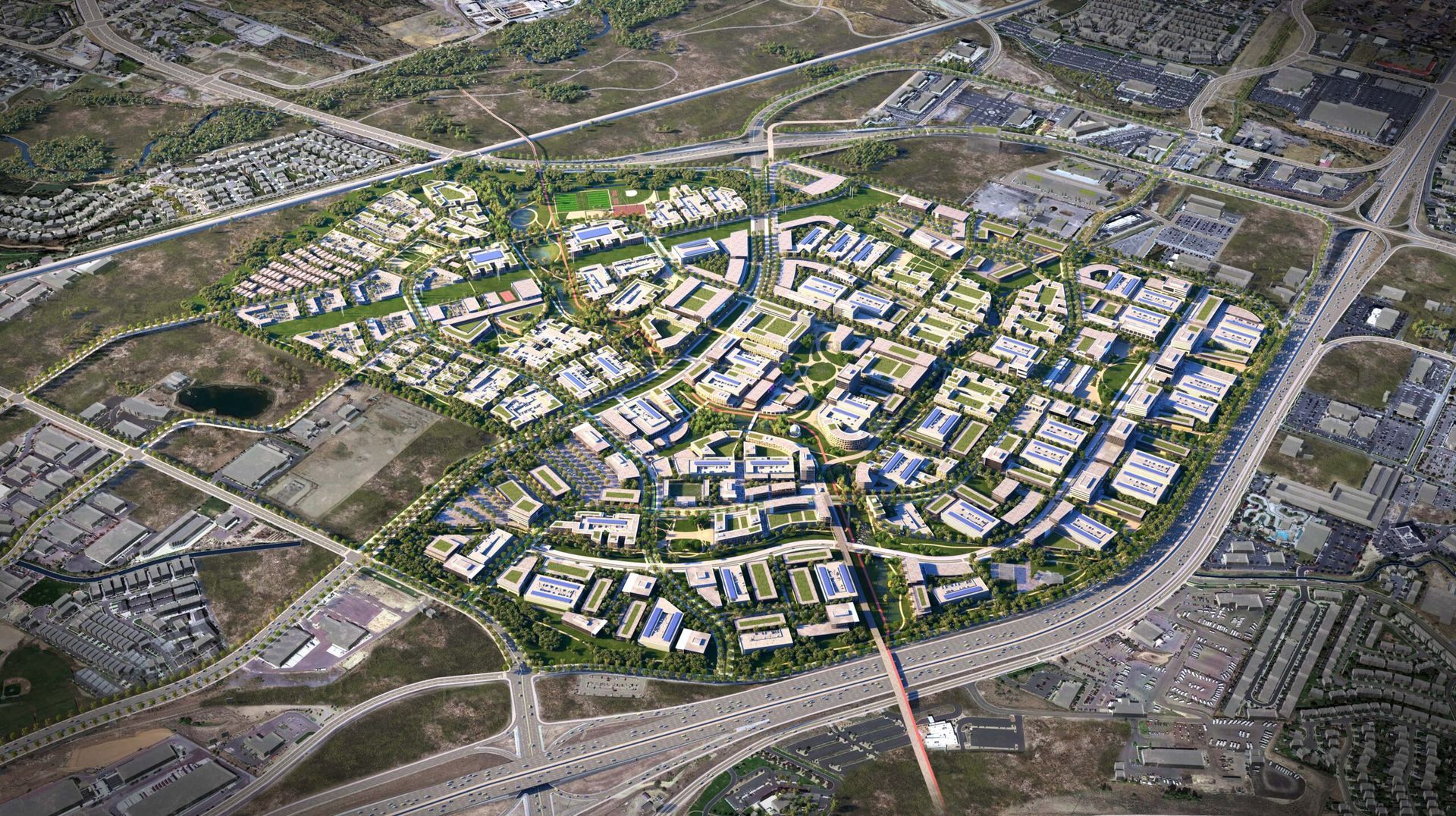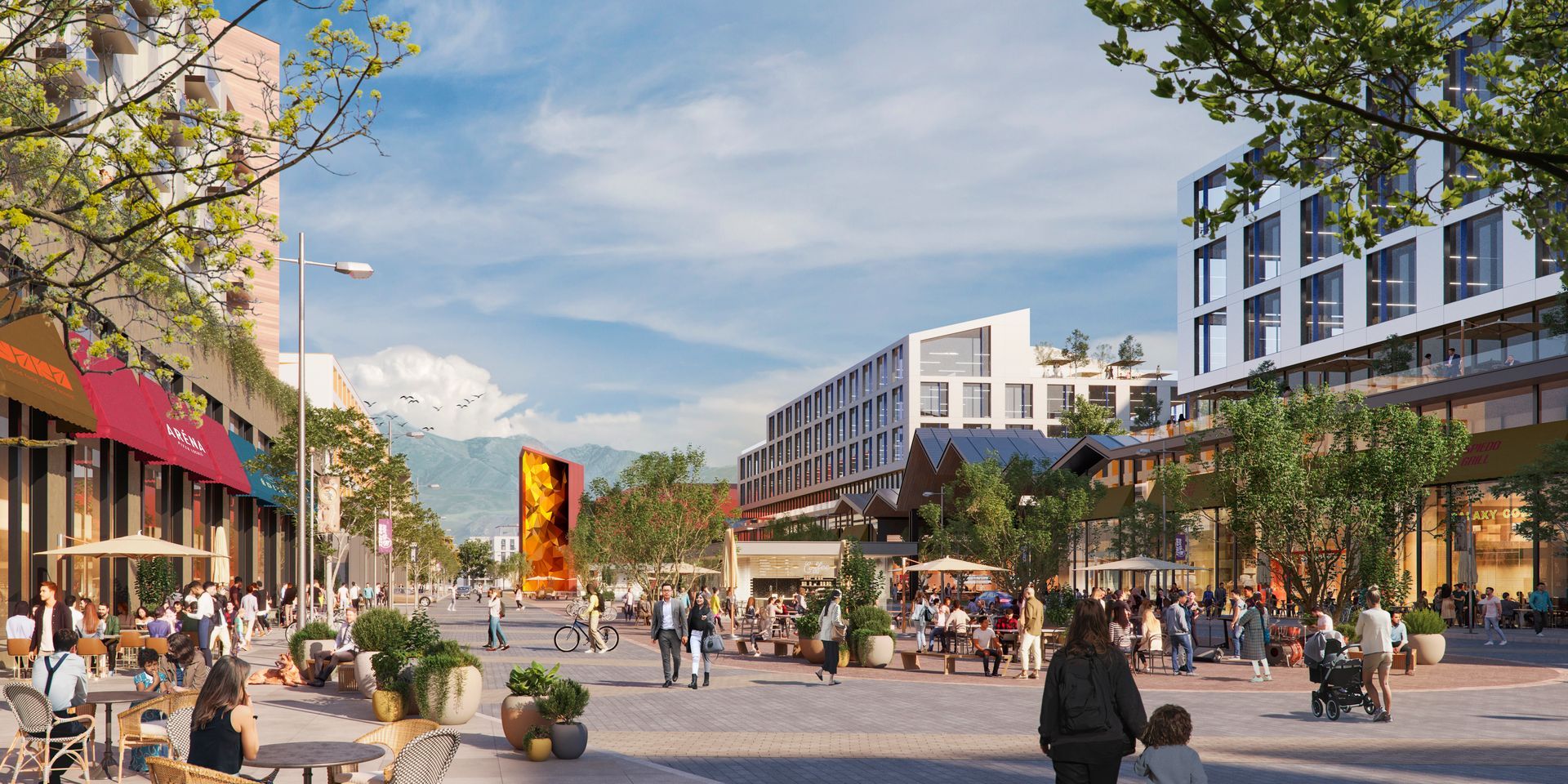Owner Spotlights

Adobe’s 680,000 SF Lehi Campus is an iconic project in Lehi that was completed in two phases, with the first phase opening at the beginning of 2013 and signaling a new era of development along the Silicon Slopes corridor. (photo by Dana Sohm) Inset: Aerial view showing an illustration of Texas Instruments’ new 300 mm semiconductor wafer manufacturing plant—referred to as “LFAB2”—which broke ground last November and marks the single largest investment (over $11 billion) in state history. (photo courtesy Texas Instruments)

“INVOLVED.” That is one word that summarizes residential developer and builder C.W. Group. And they are involved in quite a bit. It’s how the company likes it. “People don’t know everything we do,” said Darlene Carter, CEO of C.W. Group. According to her, their work in residential development, design, and construction is profound in depth and wide in breadth. Throughout the overall company, they are homebuilders (Cole West Home), master-planned community land developers (C.W. Land Co.), commercial general contractors (Cole West Development)—and don’t forget their work in residential real estate development, architecture and design, commercial construction, and boutique urban and infill multifamily projects (C.W. Urban, and in-house architecture firm, C.W. Design). Intentional Work Leads to Growth Affordable housing, single-family homes, apartments, townhomes, nightly rentals, senior housing, you name it, C.W. Group is involved. "Every demographic or product type,” began Carter, CEO of C.W. Group. “We have an offering for them somewhere.” What sets them apart isn’t that they do so much, said Colin Wright, Founder of C.W. Group. It is the volume, the quantity, “and we do it intentionally.” The intentionality of the firm is present in everyone in the company, said the executives. “The energy here on a daily basis is unmatched anywhere. It’s not pro forma for us,” said Wright. Intentionality from C.W. Group comes from thinking about everything—future residents, neighborhood, market conditions, cultural attitudes, and more—and how all of it relates to the whole. “It’s countertops, it’s families,” said Colin before pausing, “I hear people talk about where [in the house] they’re going to put the doggy doors.” The company’s intentionality has brought it a long way. Cole West Home and Cole West Development have experienced explosive growth since their inception in 2016 and specifically during the pandemic. Together with the work done via C.W. Land Co.—and the award-winning work from C.W. Urban and C.W. Design, 2021 Most Outstanding Adaptive Reuse Project winners with theCHARLI—the firm is poised to create a greater number of livable and vibrant communities. Full Service, Full Experience In an industry that struggles to change, C.W. Group wants to be dynamic in every sense of the word. One way they do that is by achieving as many things as possible in-house. “We are involved in so much,” said Carter. “Every single day gives us a new way to look at every project. […] Our culture of creativity and our ability to change [quickly]” is a strategic advantage for the firm. “By doing everything in-house, we eliminate a lot of wasted time coordinating” and therefore “get things across the finish line faster, because we have more time for execution,” said Carter. They continue to buy into the collaborative nature of construction and design. “Having the team under one roof is one of our biggest strengths. All team members are working towards a collective goal, and the synergy that creates is truly invaluable.” The in-house nature of C.W. Group has another benefit. It allows everyone on the team to be accountable to each other. “Too much of our industry is passing the buck,” said Bryce Willardson, VP of Commercial Operations for C.W. Urban. The firm has a plan to avoid the fragmented and often litigious nature of the A/E/C industry and is sticking to it. Mistakes still happen, he said, “but it’s on us to fix them. […] When there is a mistake, it’s ours and we have to own it. The speed of trust and knowing that fellow team members are looking at projects with the same end goal in mind helps set the company apart from others. And it isn’t just the executive suite touting an idea. It is how they treat their partners, too. “We really rely on subcontractors and engineers to bring their minds together to ‘MacGyver’ these projects,” said Jon Galbraith, VP of Architecture and Design for C.W. Urban. “There’s no other way to be successful nowadays,” so he and his colleagues continue to lean into and trust those around them.

Established in 1981, the State of Utah’s Division of Facilities Construction and Management (DFCM) has been among the state’s most prominent owners—public or private—with stewardship of an eye-popping 3,900 buildings across Utah. The agency finds itself as busy as ever on the heels of completing the 2022 Utah Legislative session, which saw legislators poring over dozens of project requests as they tried to figure out the best way to divvy up some $2 billion in funding. “This legislative session was pretty crazy,” said DFCM Director Jim Russell on March 18 at a presentation to the AGC of Utah in Salt Lake City. “They ended with about a $2 billion surplus to spend and they had $6 billion in requests, so it was a little difficult to manage this year. There were projects popping up in virtually every committee. We were scrambling trying to make sure we had an adequate budget for all the projects presented. Overall, we got about $1.8 billion in projects, so that’s good news for the local [construction] community.” Russell said DFCM currently has 469 active projects totaling more than $4.3 billion, a sizable number to say the least. One of the most prominent of those projects is a new $210-million North State Capitol Building, a CM/GC project currently in design that received $68 million in new money to get it fully funded. DFCM employees moved out of their former home near the Utah State Capitol in January 2020 to clear the site for demolition and reconstruction. They have been patiently dealing with the challenges of remodeling the new digs in West Valley City, the site of a former American Express call center that is a $107 million total project—$30 million for the building/land purchase, $77 million in renovation costs. That number is a far cry from the originally projected $335 million price tag that had been estimated. Plus, Russell said it consolidates myriad State of Utah agencies (13 total) into one building, totaling some 765 state employees (DFCM has close to 200 employees). “They’re remodeling around us; for some reason, the only place they ever work—hammering and drilling—is right above my desk,” Russell joked during an interview in mid-January. “It was completely gutted—it’s about as deep of a remodel as you can do. It’s going to be an open space concept. This helps with hiring and retention and for us to be somewhat competitive. Your [office] spaces factor into what people are looking for. We’re vacating four buildings and at least that many leases and moving everyone into this one facility.” As Russell mentioned, business is brisk and expected to keep rolling with the agency’s 700-project, $4-billion backlog. “It’s been like this the past few years,” he shrugged. He’s been with the DFCM for nearly two decades and has seen budgets grow with the population increases. “15 years ago, we were doing $2 billion [annually].” “It’s an exceptionally busy time given the amount of work we have and other constraints,” said Matt Boyer, Assistant Director for Capital Development. Russell acknowledged the solid working relationship and partnership that exists between DFCM and A/E/C firms. He and his staff understand the value that designers and contractors bring to the equation. “We feel we have a good working relationship with our A/E/C community,” he said. “We’re grateful for the partnership and for what you do. There is a lot of confidence in what we do, and we can’t do that without you. We have great designers, great contractors, and great subs that take pride in what they do.” Higher Education Remains Priority Utah’s youthful demographics—far and away the lowest median age in the country (31.2; the average is 38.5)—has been a driving factor in spurring new buildings on university and technical college campuses to keep up with projected demands over the next 20 years. Russell showed a list of 12 higher ed/tech college projects either in planning/programming or design that received a combined $600 million in state funding, led by $120 million each for the Utah Valley University (UVU) Engineering Building and the University of Utah (U of U) Computing & Engineering Building, $80 million to the Utah State University (USU) College of Veterinary Medicine, and $56 million to a Utah Technical University General Classroom Building. Nine other non-state-funded higher education projects totaling $640 million were also listed, including the much-anticipated $400-million U of U West Valley Health and Community Center. Other key projects on that list include the $62-million U of U Indoor Practice Facility, Campus View Suites Phase III at Utah Technical University (UTU), and nearly $48 million for the U of U’s Kahlert Village Fourth Wing. Russell also mentioned $191 million in state funding that will be directed to approximately 400 DFCM Capital Improvement Projects, of which 80 are delegated between USU and the U of U. One other noteworthy project at the U of U getting closer to being fully funded is the nearly $400-million School of Medicine, which has been funded to $285 million so far. Material price increases are necessitating another $60 million from the state and more from private donors. Russell admits that occasional critics will guffaw about what they feel are exorbitant costs for certain higher education projects—“Sometimes we get accused of building Taj Mahals”—but he remains steadfast that DFCM does its best to earn the trust of legislators and the public in general. There have been recent discussions on doing more renovations and repurposing old buildings on school campuses, rather than building completely new structures. With all signs pointing to projects just getting more costly due to material spikes, supply chain shortages, and rising inflation, there is a chance the legislature could halt construction funding for 2023 on some or all major projects. “Some projects are over budget; if costs keep going up, the legislature may not want to build any more buildings. It’s important to get our arms around it,” said Russell, adding that since 2015 there has been a 38% escalation in project costs, with last year at 13% and this year projected again at 13%. “Prices are significantly higher—we always battle that. If the legislature paused [construction funding] for a year or two, that would have an obvious [negative] effect on our economy.”




















